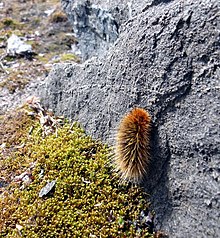Gynaephora groenlandica
| Arctic woolly bear moth | |
|---|---|
 |
|
| Arctic woolly bear caterpillar, Baffin Island | |
| Scientific classification | |
| Kingdom: | Animalia |
| Phylum: | Arthropoda |
| Class: | Insecta |
| Order: | Lepidoptera |
| Family: | Lymantriidae |
| Genus: |
Gynaephora Hübner, 1819 |
| Binomial name | |
|
Gynaephora groenlandica (Wocke, 1874) |
|
Gynaephora groenlandica, the arctic woolly bear moth, is a lymantriid moth found within the Arctic Circle, in Greenland and Canada. It is best known for its very slow rate of development. It was once estimated that it had a 14-year lifecycle from egg to adult moth, unique among the Lepidoptera with the ability to withstand temperatures below −60°C. The larvae degrade their in preparation for overwintering and resynthesize them in the spring, and each instar of the caterpillar takes about a year. Subsequent studies have revised the lifecycle duration to be 7 years.
The Arctic woolly bear caterpillars are unique in their combination of adaptations to the polar extremes. They spend nearly 90% of their lives frozen and only about 5% feeding on the tundra during June; the remainder is spent in summer aestivation within hibernacula (protective cocoons).
Hiding within hibernacula serves several functions: protection from insect parasitoids that kill about 75% of the larvae and pupae, avoidance of secondary metabolites built up in their food source, the Arctic willow, degradation of linked to hypometabolism and antifreeze synthesis, and conservation of energy reserves needed to synthesize cryoprotective compounds required for freezing survival.
Two insect parasitoids attack woolly bear moth caterpillars: an ichneumonid wasp (reported as Hyposoter pectinatus but probably Hyposoter deichmanni) and a tachinid fly (Exorista thula). The wasp, a solitary parasitoid, kills about 20% of the third and fourth instars of the host while the gregarious bristle fly causes about 50% mortality in the instar 5 and 6, and pupae.
The extreme winter temperatures are not as detrimental to Gynaephora caterpillars as are the parasitoids. The larvae are extremely freeze-tolerant, able to survive temperatures down to -70°C. As temperatures decrease during the late arctic summer, the larvae start synthesizing cryoprotective compounds, such as glycerol, in addition to some unusual ones, e.g. betaine. Accumulation of these "antifreezes“ is aided by bottle-necking of oxidative phosphorylation through mitochondrial degradation. The woolly bears resynthesize the mitochondria the following spring upon resumption of their activity.
...
Wikipedia
